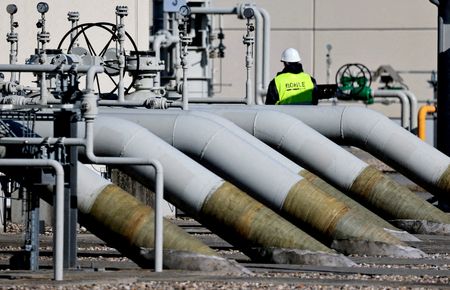LONDON – Unexplained damage to the Nord Stream pipelines that run under the Baltic Sea have dashed hopes that Russian gas flow to Germany will resume anytime soon.
Nord Stream 1 had been idle since the end of August for maintenance work, prompting concerns about supply to Europe if the outage was extended.
It has also cut off supply to several European countries such as Bulgaria, Denmark, Finland, the Netherlands and Poland, and reduced flows via other pipelines since launching what Moscow calls its “special military operation” in Ukraine.
The following outlines Europe’s options.
WHAT ARE THE MAIN ROUTES FOR RUSSIAN GAS TO EUROPE?
Russia typically supplies about 40% of Europe’s natural gas, mostly by pipeline. Deliveries last year were around 155 billion cubic metres (bcm).
Via Ukraine the gas goes mainly to Austria, Italy, Slovakia and other east European states. The Ukrainian transmission system operator has declared force majeure at the Sokhranovka entry point pipeline that runs through Russian-occupied territory in the east of the country.
But around 42 million cubic metres (mcm) per day is still pumped through Ukraine via the Sudzha route.
Alternative routes to Europe that do not go via Ukraine include the Yamal-Europe pipeline, which crosses Belarus and Poland to Germany.
The Yamal-Europe pipeline has a 33 bcm capacity, around a sixth of Russian gas exports to Europe. Flows have been reversed to flow eastward between Poland and Germany since the start of this year and been declining.
Moscow has placed sanctions on the owner of the Polish part of the Yamal-Europe pipeline. However, Poland can manage without reverse gas flow on the Yamal pipeline, its climate minister has said.
Both Nord Stream 1 and Nord Stream 2 pipelines, built to supply Russian gas to Europe via Germany, were damaged by blasts and will need major rebuilding works. Germany halted certification of the new Nord Stream 2 gas pipeline from Russia because of the Ukraine war so it never went into operation.
Russian President Vladimir Putin proposed in October to build a gas hub in Turkey as an alternative supply route — a plan backed by Turkish President Tayyip Erdogan.
Russia has also said it could pump gas via a Nord Stream 2 line which wasn’t damaged, but Germany has not agreed to this.
EUROPE’S ALTERNATIVE SUPPLIERS?
Some countries have alternative supply options and Europe’s gas network is linked up so supplies can be shared, although the global gas market was tight even before the Ukraine crisis.
Germany, Europe’s biggest consumer of Russian gas, can import gas from Britain, Denmark, Norway and the Netherlands via pipelines.
Norway, Europe’s second biggest gas supplier behind Russia, has been raising production to help the European Union towards its target of ending reliance on Russian fossil fuels by 2027.
Britain’s Centrica has signed a deal with Norway’s Equinor for extra supply for the next three winters. Britain does not rely on Russian gas and can also export to Europe via pipelines.
Southern Europe can receive Azeri gas via the Trans Adriatic Pipeline to Italy and the Trans-Anatolian Natural Gas Pipeline (TANAP) through Turkey.
Liquefied natural gas (LNG) imports to Europe have increased from producers such as the United States, Qatar and other countries.
But unplanned disruptions in these countries due to production capacity, incidents and climate hazards can squeeze supply.
Europe’s LNG terminals also have limited capacity for extra imports and multiples ships carrying LNG are unable to secure slots to offload their cargo. Those ships may start looking for alternative ports outside Europe if the backlog remains.
Germany is among several countries who want to build new LNG terminals. It plans to build five.
Poland, which relies on Russia for about 50% of its gas consumption or around 10 bcm, has said it can source gas via two links with Germany.
The Baltic Pipe from Norway to Poland via Denmark started operations on Oct. 1, although it is initially being filled with gas from Germany. It has a capacity of up to 10 bcm/year.
The opening of a Danish terminal for Norwegian gas to be pumped through the new Baltic Pipe pipeline to Poland has been delayed by almost two weeks to Nov. 1.
Poland also commissioned a new gas link with Slovakia in August and asked the Commission end-September to provide funding for a new gas pipeline connecting the Czech Republic to its network and LNG terminals.
Spain and Germany has been pushing for the construction of a new gas connection through the Pyrenees mountains but France opposed the initiative, saying new LNG terminals, which can be made to float, would be a quicker and cheaper option than a new pipeline.
OTHER OPTIONS TO COPE WITH A GAS SUPPLY CRUNCH?
Several nations can seek to fill any gap in energy supplies by turning to electricity imports via interconnectors from their neighbours or by boosting power generation from nuclear, renewables, hydropower or coal.
Nuclear availability is falling in Belgium, Britain, France and Germany with plants facing outages as they age, are decommissioned or phased out. Hydro levels have been falling this summer due to low rainfall and a heatwave.
Europe has been trying to shift from coal to meet climate targets but some plants have been switched back to secure enough energy for this winter and to curb rising energy prices.
Energy ministers agreed that all EU countries should voluntarily cut gas use by 15% from August to March, compared with their average annual use during 2017-2021 and introduced EU-wide targets for refilling gas storage.
Countries across Europe are also preparing for possible power shortages, blackouts and energy rationing. France launched a national energy savings plan to reduce energy consumption while Britain has warned of three-hour planned power cuts for homes and businesses as a last resort.
The European Commission has proposed a package of emergency measures to tackle the energy crisis, including for member states to start jointly buying gas.
(Compiled by Dina Kartit; editing by Nina Chestney)

